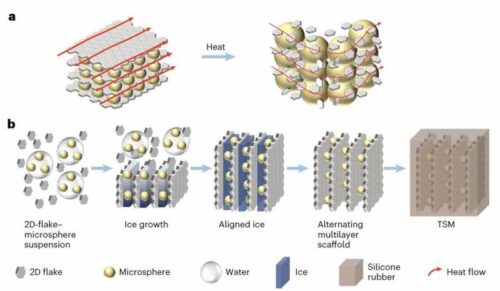This could be the key to safely deploying large-capacity batteries, ensuring performance and safety across various climates and operating conditions.

High-capacity lithium-ion batteries (LIBs) are poised to revolutionize the electrification of vehicles and large electronics. However, to deploy these batteries on a large scale, engineers must ensure they operate safely across a range of temperatures and avoid explosions when overheated. A standard safety solution for LIBs is using thermal-conducting interlayers, which evenly distribute heat between a battery’s modules, maintaining temperatures between 15 to 45 °C. For high-capacity LIBs, these interlayers must be highly thermally insulating to prevent heat propagation while ensuring uniform temperature distribution. Researchers at Tsinghua University and Zhejiang University have designed a new thermal-switching material that meets these criteria, effectively regulating the temperature in high-capacity batteries. This material, introduced in a paper in Nature Energy, responds rapidly to temperature changes, enabling safe battery cycling in various operating conditions.
The thermal-switching material is composed of microspheres embedded between connected graphene layers. These microspheres expand in response to temperature changes, disrupting heat transport by separating neighboring 2D graphene layers, thus regulating the temperature within battery cells and preventing explosions.To test their design, the researchers integrated this material into a 50 Ah Ni-Co-Mn LIB as a cell-to-cell interlayer. The results were promising: the material effectively acted as a thermal regulator, preventing heat propagation and chain reactions that could lead to explosions.This thermal regulator could soon be tested on other high-capacity batteries and contribute to their widespread commercialization, ensuring safety in various climates and operating conditions. The researchers believe this thermally responsive material design will ensure safety and high performance throughout the lifespan of high-energy-density battery modules.
The team noted that Effective thermal safety management relies on the thermal conductivity of interlayer materials, yet current designs lack the needed responsiveness for both performance and safety. To address this predicament, they design a thermal-switching material with a high switching ratio from thermal conduction to thermal insulation state.The designed thermal-switching material exhibits a wide temperature range for heat conduction (1.33 W m−1 K−1 at room temperature) and can transform to an adiabatic state within 30 seconds (0.1 W m−1 K−1 at around 100 °C) when heated. When applied as cell-to-cell interlayers for a module with four 50 Ah nickel–cobalt–manganese lithium-ion cells, the material not only ensures uniform temperature distribution under normal conditions but also prevents 80% of heat transmission from thermal runaway, effectively avoiding catastrophic battery explosions.






